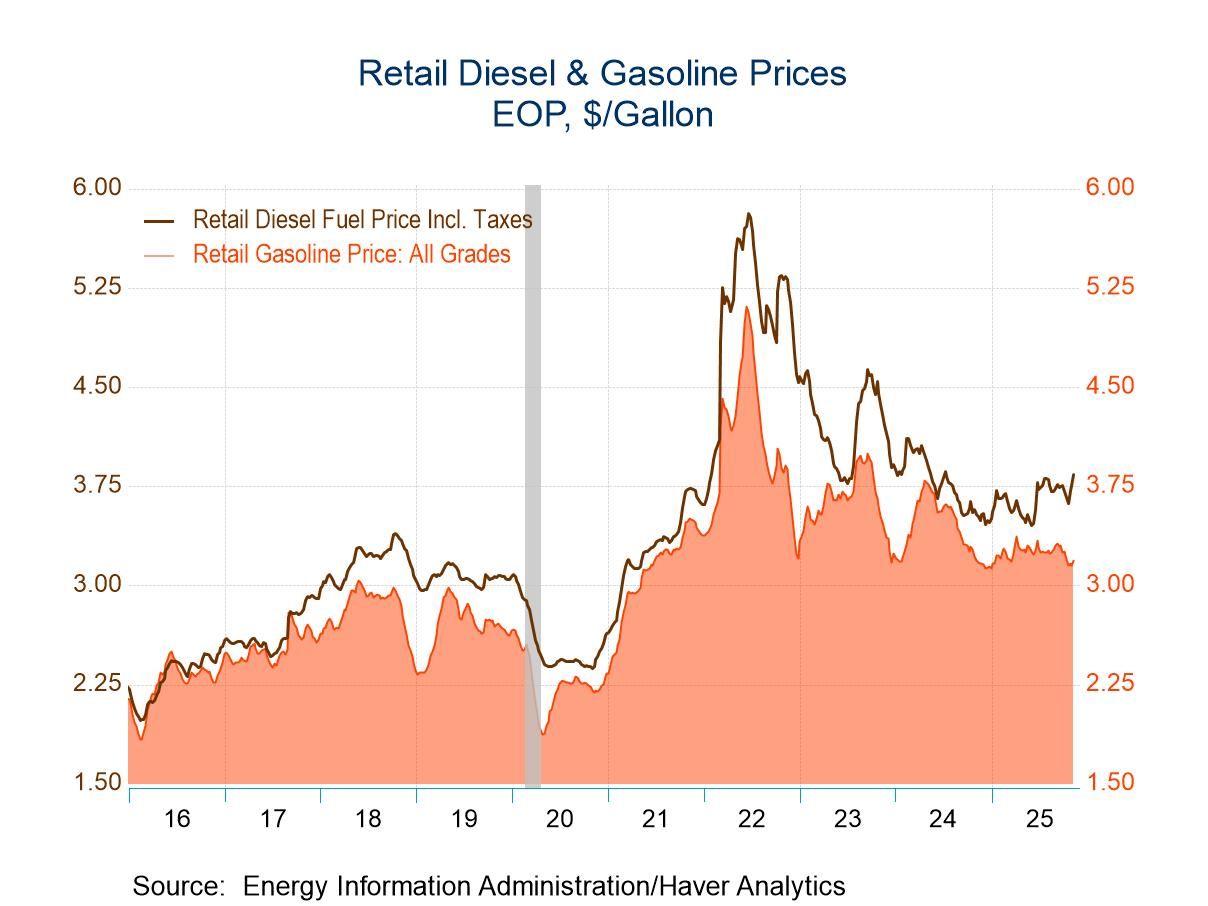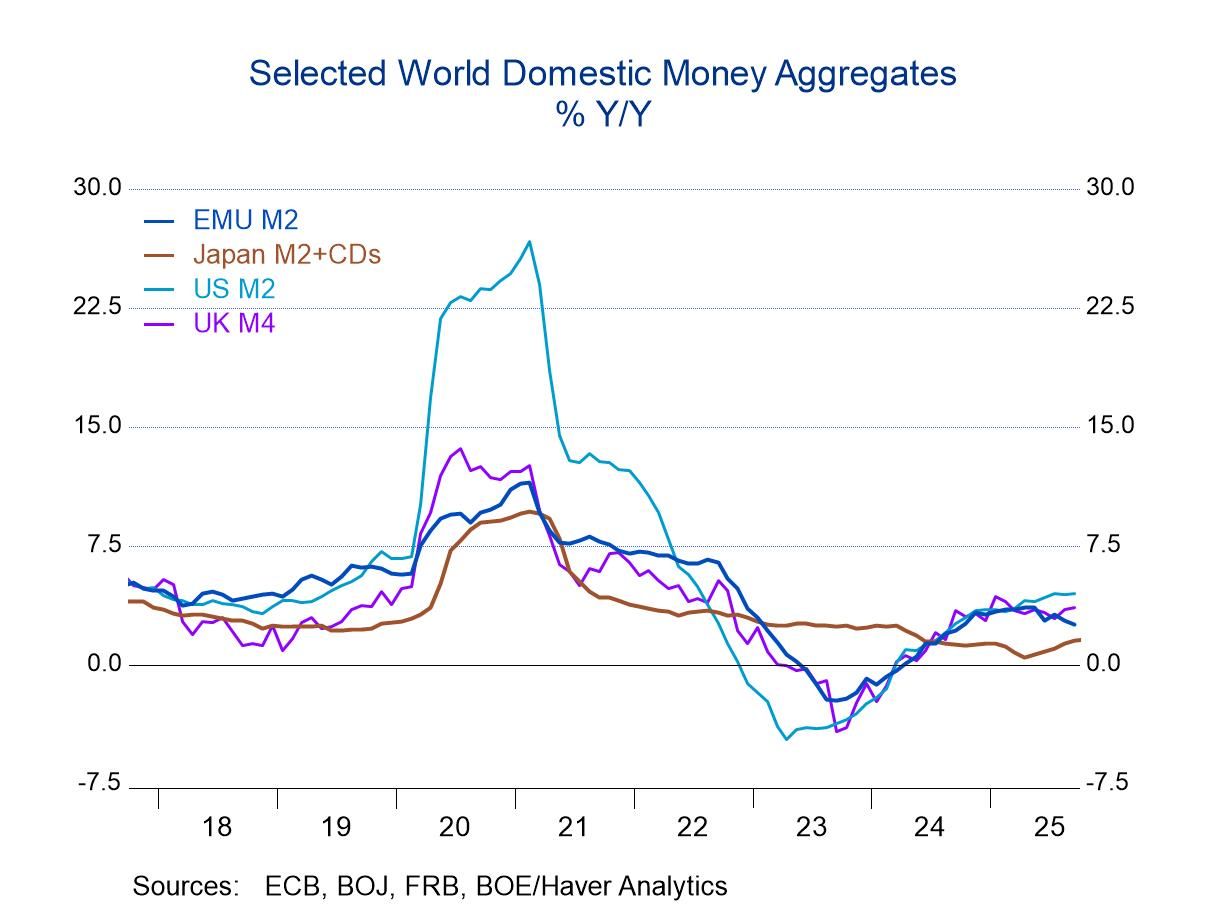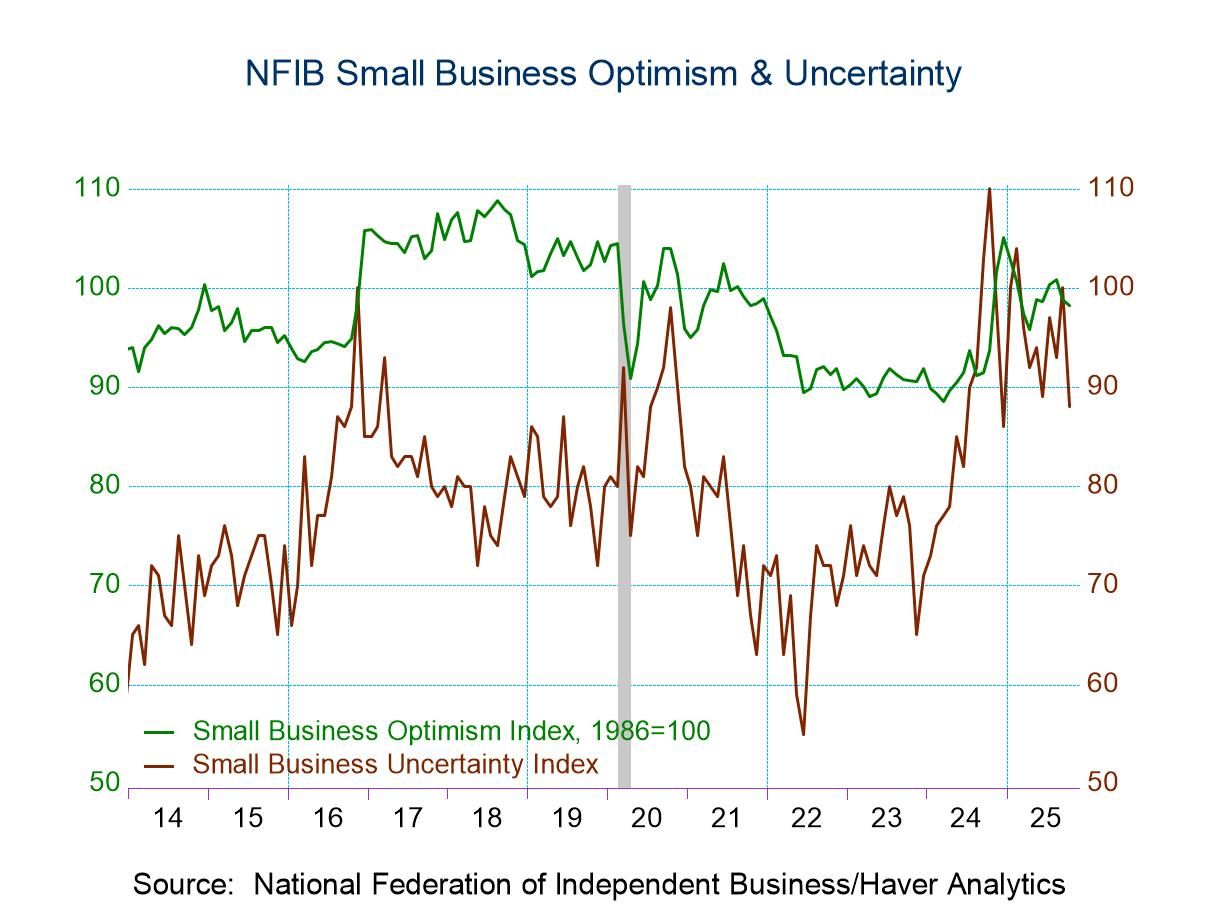 Global| Dec 01 2015
Global| Dec 01 2015U.S. Gasoline Prices Decline; Crude Oil Nudges Higher
by:Tom Moeller
|in:Economy in Brief
Summary
Gasoline prices at the pump declined last week to $2.06 per gallon, off 3 cents from the prior week. Prices were down 25.9% y/y and roughly equaled the January low of $2.04. Haver Analytics constructs factors adjusting for the [...]
Gasoline prices at the pump declined last week to $2.06 per gallon, off 3 cents from the prior week. Prices were down 25.9% y/y and roughly equaled the January low of $2.04. Haver Analytics constructs factors adjusting for the seasonal variation in pump prices. The seasonally adjusted price declined to $2.19 per gallon. Moving the other way, the spot market gasoline price increased to $1.43 per gallon (-33.1% y/y).
WTI crude oil costs nudged up to $41.23 (-43.0% y/y). Prices reached $107.23 in June 2014. Yesterday, prices improved slightly to $41.65 per barrel. Brent crude oil prices increased w/w to $43.63 per barrel and were $43.73 yesterday.
Natural gas prices eased last week to $2.10 per mmbtu (-49.5% y/y) and were $2.09 yesterday.
Gasoline demand eased 0.2% y/y last week but demand for all petroleum products declined 1.8% y/y. Gasoline inventories increased 5.0% y/y and inventories of all petroleum products rose 10.4% y/y. Crude oil production (input to refineries) increased 1.5% y/y during the last four weeks.
The energy price data are reported by the U.S. Department of Energy. The petroleum demand and inventory figures are from the Oil & Gas Journal Weekly. These data can be found in Haver's WEEKLY database. The daily figures are in DAILY and greater detail on prices, demand and production, along with regional breakdowns, are in OILWKLY.
| Weekly Energy Prices | 11/30/15 | 11/23/15 | 11/16/15 | Y/Y% | 2014 | 2013 | 2012 |
|---|---|---|---|---|---|---|---|
| Retail Gasoline ($ per Gallon, Regular) | 2.06 | 2.09 | 2.18 | -25.9 | 2.30 | 3.33 | 3.30 |
| Light Sweet Crude Oil, WTI ($ per bbl., WSJ) | 41.23 | 40.62 | 42.70 | -43.0 | 93.64 | 97.96 | 94.20 |
| Natural Gas ($/mmbtu, LA, WSJ) | 2.10 | 2.12 | 2.07 | -49.5 | 4.37 | 3.73 | 2.75 |
U.S. ISM Factory Index Falls to Lowest
Level Since 2009 Activity in the manufacturing sector declined last month according the
Institute for Supply Management. Its Composite Index of factory sector activity
fell to 48.6 during November from an unrevised October reading of 50.1. This was
the lowest level since June 2009, the final month of the last recession. The
decline compared to rough stability at 50.4 called for in the Action Economics
Forecast Survey. Declines in most component series were evident. The new orders figure fell to
48.9, the lowest level since March 2009 while the production reading also moved
below break-even to 49.2. These declines reflected an effort to reduce
inventories as the index fell to 48.0, down sharply for the second straight
month. These declines didn't keep manufactures from raising employment. The jobs
index rose to 51.3, its highest level since July. During the last ten years
there has been an 88% percent correlation between the index and the m/m change
in factory sector payrolls. The supplier delivery index also edged up to 50.6,
indicating the slowest delivery speeds in three months. Weaker activity readings led to reduced pricing power. The prices index fell
to 35.5, is lowest level since April 2009. Thirty percent (NSA) of respondents
reported paying lower prices while just 1% reported them higher. The export order index held steady m/m at 47.5, but was down from the 2011
high of 62.5. The import index nudged up to 49.0 and the order backlog index
gained to 43.0. The figures from the Institute For Supply Management (ISM) are diffusion
indexes. A reading above 50 represents growth in factory sector activity. They
can be found in Haver's USECON database. The expectations number is in
the AS1REPNA database.
by Tom Moeller December
1, 2015
ISM Mfg (SA)
Nov
Oct
Sep
Nov '14
2014
2013
2012
Composite Index
48.6
50.1
50.2
57.6
55.7
53.8
51.7
New Orders
48.9
52.9
50.1
62.1
59.0
56.9
52.9
Production
49.2
52.9
51.8
62.6
59.2
57.5
53.7
Employment
51.3
47.6
50.5
54.6
54.5
53.2
53.8
Supplier Deliveries
50.6
50.4
50.2
57.0
55.0
51.9
50.0
Inventories
43.0
46.5
48.5
51.5
50.8
49.4
48.2
Prices Paid Index (NSA)
35.5
39.0
38.0
44.5
55.6
53.8
53.2
U.S. Construction Activity Continues to Strengthen
by Tom Moeller December 1, 2015
The value of construction put-in-place increased 1.0% during October following an unrevised 0.6% September increase. Three-month growth of 10.4% (AR) was steady with Q3 but down sharply from 29.2% during Q2. A 0.5% October rise had been expected in the Action Economics Forecast Survey.
Building activity in the private sector increased 0.8% following a 0.9% September gain. Activity increased at an 11.3% rate during the last three months. Residential building activity rose 1.0% (18.3% y/y), the seventh consecutive month of strong gain. The gain was led by a 1.6% increase in single-family building (11.3% y/y) which equaled the strongest rise of the year. Multi-family building rose 1.4% (27.2% y/y). Spending on improvements eased 0.3% (+21.5% y/y). Nonresidential building improved 0.6% (14.4% y/y) as factory sector construction rose 3.0% (37.6% y/y).
Public sector building increased 1.4% (5.6% y/y) following three months of little change. Water supply spending rose 2.5% (5.3% y/y) and office construction jumped 1.8% (7.2% y/y). Highway and street construction increased 1.1% (5.2% y/y) but power construction declined 5.2% (-8.7% y/y).
The construction spending figures are in Haver's USECON database and the expectations figure is contained in the AS1REPNA database.
| Construction Put in Place (SA, %) | Oct | Sep | Aug | Oct Y/Y | 2014 | 2013 | 2012 |
|---|---|---|---|---|---|---|---|
| Total | 1.0 | 0.6 | 0.9 | 11.7 | 4.8 | 6.6 | 9.2 |
| Private | 0.8 | 0.9 | 1.0 | 14.3 | 6.0 | 11.3 | 15.9 |
| Residential | 1.0 | 1.6 | 1.7 | 16.2 | 1.0 | 19.5 | 14.9 |
| Nonresidential | 0.6 | 0.2 | 0.2 | 12.4 | 11.3 | 3.6 | 16.9 |
| Public | 1.4 | -0.1 | 0.7 | 5.6 | 1.9 | -3.1 | -2.5 |
U.S. Light Vehicle Sales Maintain 15-Year High;
Imported Truck Sales Surge Total sales of light vehicles edged 0.4% higher during October to
18.24 million units (SAAR). The gain followed a total increase of 6.9% during
the prior three months and left sales 10.0% higher than one year ago. Total unit
sales were at the highest level since July 2005. A 0.2% dip in light truck sales understates the dynamic behind last
month's truck market -- a surge in imports and a decline in domestic sales.
Imports' 1.9% gain to 1.62 million units was to a record high, with sales nearly
50% higher versus a year ago. The strength came at the expense of domestic truck
sales which eased 3.0% but were still 14.8% higher than last year. Passenger car sales increased 1.3% (0.4% y/y) after a 2.3% September
rise. Sales were barely higher (0.4%) than one year ago. Imported car sales
paced last month's increase with a 1.9% rise. The gain, however, did not make up
September's loss and sales of imports remained 0.8% lower than last year. Sales
of domestic passenger cars fared somewhat better and gained 1.0% after a 4.1%
surge in the month prior. Here again, though, the y/y comparison is a
less-than-inspiring 0.9%. Imports share of the market for light vehicles rose m/m to 20.5%,
still lower than a high of 30.7% in February 2009. Imports share of the light
truck market jumped to 15.8%, its highest since March 2011. Imports share of the
passenger car market was little changed m/m at 26.4%, remaining below the 34.8%
peak during all of 2010. U.S. vehicle sales figures are published by Autodata and can be found in
Haver's USECON database.
by Tom Moeller December
1, 2015
Light Vehicle Sales (SAAR,
Mil. Units)
Nov
Oct
Sep
Nov Y/Y %
2014
2013
2012
Total
18.24
18.17
10.0
16.52
15.59
14.49
Autos
8.01
7.91
0.4
7.92
7.77
7.42
Domestic
5.89
5.83
0.9
5.68
5.48
5.10
Imported
2.12
2.08
-0.8
2.24
2.30
2.32
Light Trucks
10.23
10.26
18.9
8.60
7.82
7.08
Domestic
8.61
8.88
14.8
7.51
6.74
6.10
Imported
1.62
1.37
46.7
1.09
1.08
0.97
Tom Moeller
AuthorMore in Author Profile »Prior to joining Haver Analytics in 2000, Mr. Moeller worked as the Economist at Chancellor Capital Management from 1985 to 1999. There, he developed comprehensive economic forecasts and interpreted economic data for equity and fixed income portfolio managers. Also at Chancellor, Mr. Moeller worked as an equity analyst and was responsible for researching and rating companies in the economically sensitive automobile and housing industries for investment in Chancellor’s equity portfolio. Prior to joining Chancellor, Mr. Moeller was an Economist at Citibank from 1979 to 1984. He also analyzed pricing behavior in the metals industry for the Council on Wage and Price Stability in Washington, D.C. In 1999, Mr. Moeller received the award for most accurate forecast from the Forecasters' Club of New York. From 1990 to 1992 he was President of the New York Association for Business Economists. Mr. Moeller earned an M.B.A. in Finance from Fordham University, where he graduated in 1987. He holds a Bachelor of Arts in Economics from George Washington University.






